Pleiotropic Functions of FoxN1: Regulating Different Target Genes during Embryogenesis and Nymph Molting in the Brown Planthopper
Abstract
1. Introduction
2. Results
2.1. Sequence Analysis and Expression Patterns of NlFoxN1
2.2. Temporal and Spatial Expression Patterns of NlFoxN1
2.3. NlFoxN1 Was Indispensable for Embryogenesis
2.4. Potential Targets of NlFoxN1 in the Eggs
2.5. NlFoxN1 Regulated Keratin Genes to Affect Molting Process
3. Discussion
4. Materials and Methods
4.1. Insects
4.2. Gene Identification and Sequence Analyses
4.3. Expression Pattern Analysis
4.4. RNAi Effects on N. lugens
4.5. Differential Expression Analysis Using RNA-seq
Supplementary Materials
Author Contributions
Funding
Conflicts of Interest
References
- Kaestner, K.H.; Knochel, W.; Martinez, D.E. Unified nomenclature for the winged helix/forkhead transcription factors. Genes Dev. 2000, 14, 142–146. [Google Scholar]
- Weigel, D.; Jäckle, H. The fork head domain: A novel DNA binding motif of eukaryotic transcription factors? Cell 1990, 63, 455–456. [Google Scholar] [CrossRef]
- Schorpp, M.; Hofmann, M.; Dear, T.N.; Boehm, T. Characterization of mouse and human nude genes. Immunogenetics 1997, 46, 509–515. [Google Scholar] [CrossRef]
- Schlake, T.; Schorpp, M.; Nehls, M.; Boehm, T. The nude gene encodes a sequence-specific DNA binding protein with homologs in organisms that lack an anticipatory immune system. Proc. Natl. Acad. Sci. USA 1997, 94, 3842–3847. [Google Scholar] [CrossRef] [PubMed]
- David, L.; David, M.P.; Janice, L.B. Association between Mouse nude Gene Expression and the Initiation of Epithelial Terminal Differentiation. Dev. Biol. 1999, 208, 362–374. [Google Scholar]
- Brissette, J.L.; Li, J.; Kamimura, J.; Lee, D.; Dotto, G.P. The product of the mouse nude locus, Whn, regulates the balance between epithelial cell growth and differentiation. Genes Dev. 1996, 10, 2212–2221. [Google Scholar] [CrossRef] [PubMed]
- Palamaro, L.; Romano, R.; Fusco, A.; Giardino, G.; Gallo, V.; Pignata, C. FOXN1 in Organ Development and Human Diseases. Int. Rev. Immunol. 2014, 33, 83–93. [Google Scholar] [CrossRef] [PubMed]
- Grabowska, A.I.; Wilanowski, T. FOXN1 Transcription Factor in Epithelial Growth and Wound Healing. Mol. Cell Boil. 2017, 37. [Google Scholar] [CrossRef] [PubMed]
- Nehls, M.; Kyewski, B.; Messerle, M.; Waldschütz, R.; Schuddekopf, K.; Smith, A.J.H.; Boehm, T. Two Genetically Separable Steps in the Differentiation of Thymic Epithelium. Science 1996, 272, 886–889. [Google Scholar] [CrossRef]
- Romano, R.; Palamaro, L.; Fusco, A.; Giardino, G.; Gallo, V.; Del Vecchio, L.; Pignata, C. FOXN1: A mster regulator gene of thymic epithelial development program. Front. Immunol. 2013, 4. [Google Scholar] [CrossRef]
- Rota, I.A.; Dhalla, F. FOXN1 deficient nude severe combined immunodeficiency. Orphanet J. Rare Dis. 2017, 12. [Google Scholar] [CrossRef] [PubMed]
- Schlake, T. The nude gene and the skin. Exp. Dermatol. 2001, 10, 293–304. [Google Scholar] [CrossRef] [PubMed]
- Lam, E.W.-F.; Brosens, J.J.; Gomes, A.R.; Koo, C.Y. Forkhead box proteins: Tuning forks for transcriptional harmony. Nat. Rev. Cancer 2013, 13, 482–495. [Google Scholar] [CrossRef] [PubMed]
- Ab Ghaffar, M.B.; Pritchard, J.; Ford-Lloyd, B. Brown Planthopper (N. lugens Stal) Feeding Behaviour on Rice Germplasm as an Indicator of Resistance. PLoS ONE 2011, 6. [Google Scholar] [CrossRef] [PubMed]
- Wang, Z.; Gerstein, M.; Snyder, M. RNA-Seq: A revolutionary tool for transcriptomics. Nat. Rev. Genet. 2009, 10, 57–63. [Google Scholar] [CrossRef] [PubMed]
- Vaidya, H.J.; Leon, A.B.; Blackburn, C.C. FOXN1 in thymus organogenesis and development. Eur. J. Immunol. 2016, 46, 1826–1837. [Google Scholar] [CrossRef]
- Zaret, K.S.; Carroll, J.S. Pioneer transcription factors: Establishing competence for gene expression. Genes Dev. 2011, 25, 2227–2241. [Google Scholar] [CrossRef]
- Andersen, S.O.; Hojrup, P.; Roepstorff, P. Insect cuticular proteins. Insect Biochem. Mol. Boil. 1995, 25, 153–176. [Google Scholar] [CrossRef]
- Hamodrakas, S.; Willis, J.H.; Iconomidou, V.A. A structural model of the chitin-binding domain of cuticle proteins. Insect Biochem. Mol. Boil. 2002, 32, 1577–1583. [Google Scholar] [CrossRef]
- Mecklenburg, L.; Nakamura, M.; Sundberg, J.P.; Paus, R. The Nude Mouse Skin Phenotype: The Role of Foxn1 in Hair Follicle Development and Cycling. Exp. Mol. Pathol. 2001, 71, 171–178. [Google Scholar] [CrossRef]
- Fu, D.J.; Thomson, C.; Lunny, D.P.; Dopping-Hepenstal, P.J.; McGrath, J.A.; Smith, F.J.; McLean, W.H.I.; Pedrioli, D.L. Keratin 9 Is Required for the Structural Integrity and Terminal Differentiation of the Palmoplantar Epidermis. J. Investig. Dermatol. 2013, 134, 754–763. [Google Scholar] [CrossRef] [PubMed]
- Smith, F. The molecular genetics of keratin disorders. Am. J. Clin. Dermatol. 2003, 4, 347–364. [Google Scholar] [CrossRef] [PubMed]
- Chen, X.; Yu, Z.; Chen, Q. Detection of keratin in insect cells. J. Histochem. Cytochem. 1996, 5, 214–218. [Google Scholar]
- Hannenhalli, S.; Kaestner, K.H. The evolution of Fox genes and their role in development and disease. Nat. Rev. Genet. 2009, 10, 233–240. [Google Scholar] [CrossRef]
- Cheah, P.Y.; Chia, W.; Yang, X. Jumeaux, a novel Drosophila winged-helix family protein, is required for generating asymmetric sibling neuronal cell fates. Development 2000, 127, 3325–3335. [Google Scholar]
- Lee, H.-H.; Frasch, M. Survey of forkhead domain encoding genes in the Drosophila genome: Classification and embryonic expression patterns. Dev. Dyn. 2004, 229, 357–366. [Google Scholar] [CrossRef] [PubMed]
- Hansen, I.A.; Sieglaff, U.H.; Munro, J.; Shiao, S.-H.; Cruz, J.; Lee, I.W.; Heraty, J.M.; Raikhel, A.S. Forkhead transcription factors regulate mosquito reproduction. Insect Biochem. Mol. Boil. 2007, 37, 985–997. [Google Scholar] [CrossRef]
- Ye, Y.-X.; Pan, P.-L.; Kang, D.; Lu, J.-B.; Zhang, C.-X. The multicopper oxidase gene family in the brown planthopper, Nilaparvata lugens. Insect Biochem. Mol. Boil. 2015, 63, 124–132. [Google Scholar] [CrossRef]
- Xue, J.; Zhou, X.; Zhang, C.-X.; Yu, L.-L.; Fan, H.-W.; Wang, Z.; Xu, H.-J.; Xi, Y.; Zhu, Z.-R.; Zhou, W.; et al. Genomes of the rice pest brown planthopper and its endosymbionts reveal complex complementary contributions for host adaptation. Genome Biol. 2014, 15. [Google Scholar] [CrossRef]
- Hu, B.; Jin, J.; Guo, A.-Y.; Zhang, H.; Luo, J.; Gao, G. GSDS 2.0: An upgraded gene feature visualization server. Bioinformatics 2014, 31, 1296–1297. [Google Scholar] [CrossRef]
- Larkin, M.; Blackshields, G.; Brown, N.; Chenna, R.; Mcgettigan, P.; McWilliam, H.; Valentin, F.; Wallace, I.; Wilm, A.; López, R.; et al. Clustal W and Clustal X version 2.0. Bioinformatics 2007, 23, 2947–2948. [Google Scholar] [CrossRef] [PubMed]
- Xu, H.-J.; Xue, J.; Lu, B.; Zhang, X.-C.; Zhuo, J.-C.; He, S.-F.; Ma, X.-F.; Jiang, Y.-Q.; Fan, H.-W.; Xu, J.-Y.; et al. Two insulin receptors determine alternative wing morphs in planthoppers. Nature 2015, 519, 464–467. [Google Scholar] [CrossRef] [PubMed]
- Pertea, M.; Kim, D.; Pertea, G.M.; Leek, J.T.; Salzberg, S.L. Transcript-level expression analysis of RNA-seq experiments with HISAT, StringTie and Ballgown. Nat. Protoc. 2016, 11, 1650–1667. [Google Scholar] [CrossRef] [PubMed]
- Li, H.; Handsaker, B.; Wysoker, A.; Fennell, T.; Ruan, J.; Homer, N.; Marth, G.; Abecasis, G.R.; Durbin, R.; 1000 Genome Project Data Processing Subgroup. The Sequence Alignment/Map format and SAMtools. Bioinformatics 2009, 25, 2078–2079. [Google Scholar] [CrossRef]
- Liao, Y.; Smyth, G.K.; Shi, W. featureCounts: An efficient general purpose program for assigning sequence reads to genomic features. Bioinformatics 2013, 30, 923–930. [Google Scholar] [CrossRef]
- Love, M.I.; Huber, W.; Anders, S. Moderated estimation of fold change and dispersion for RNA-seq data with DESeq2. Genome Biol. 2014, 15. [Google Scholar] [CrossRef]
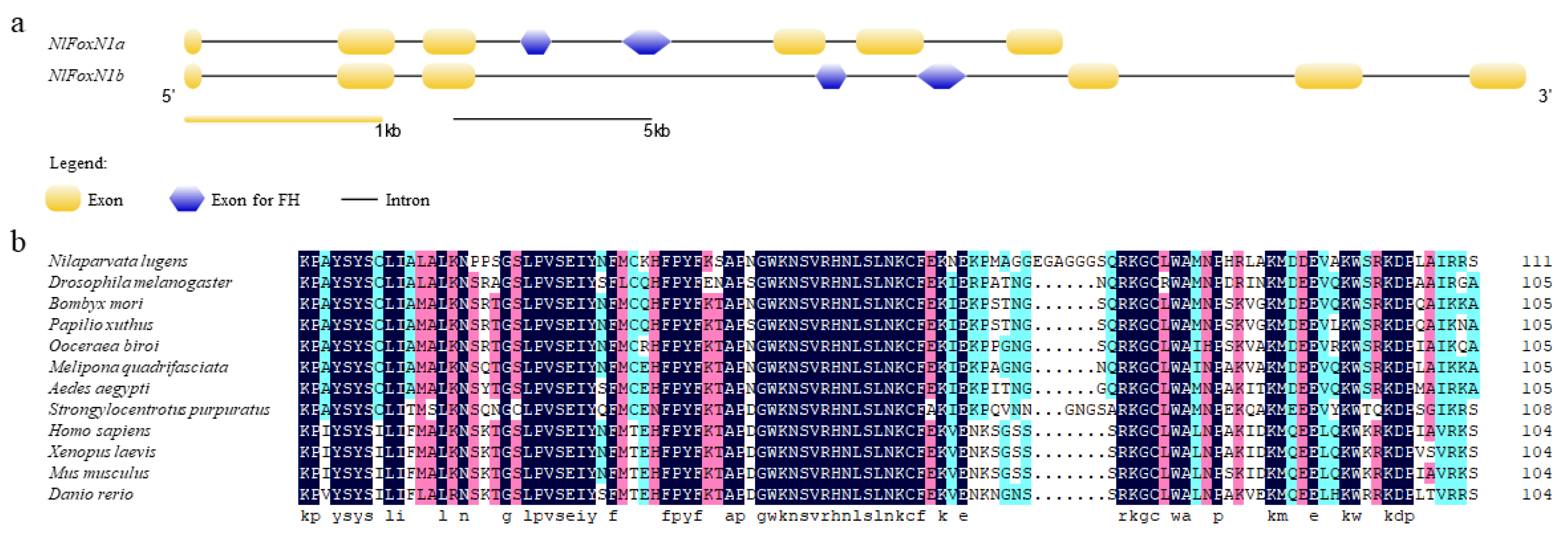
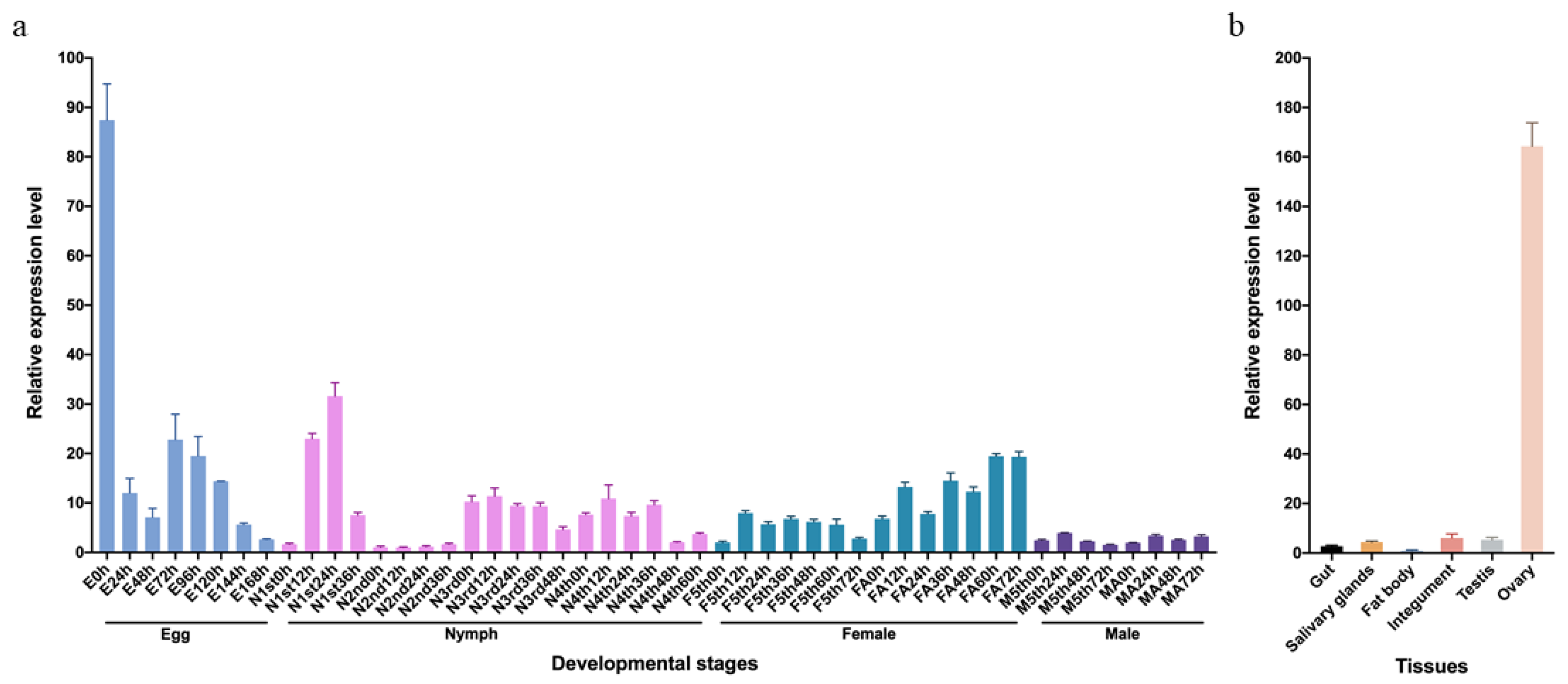

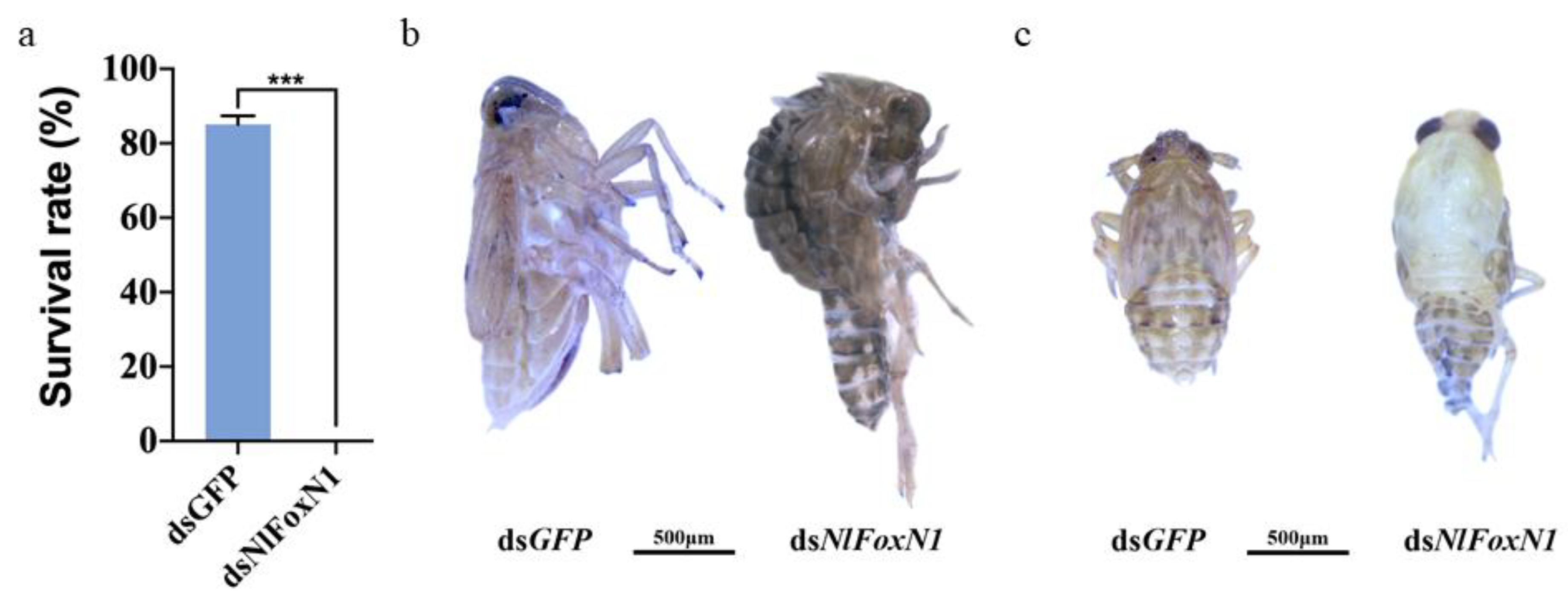
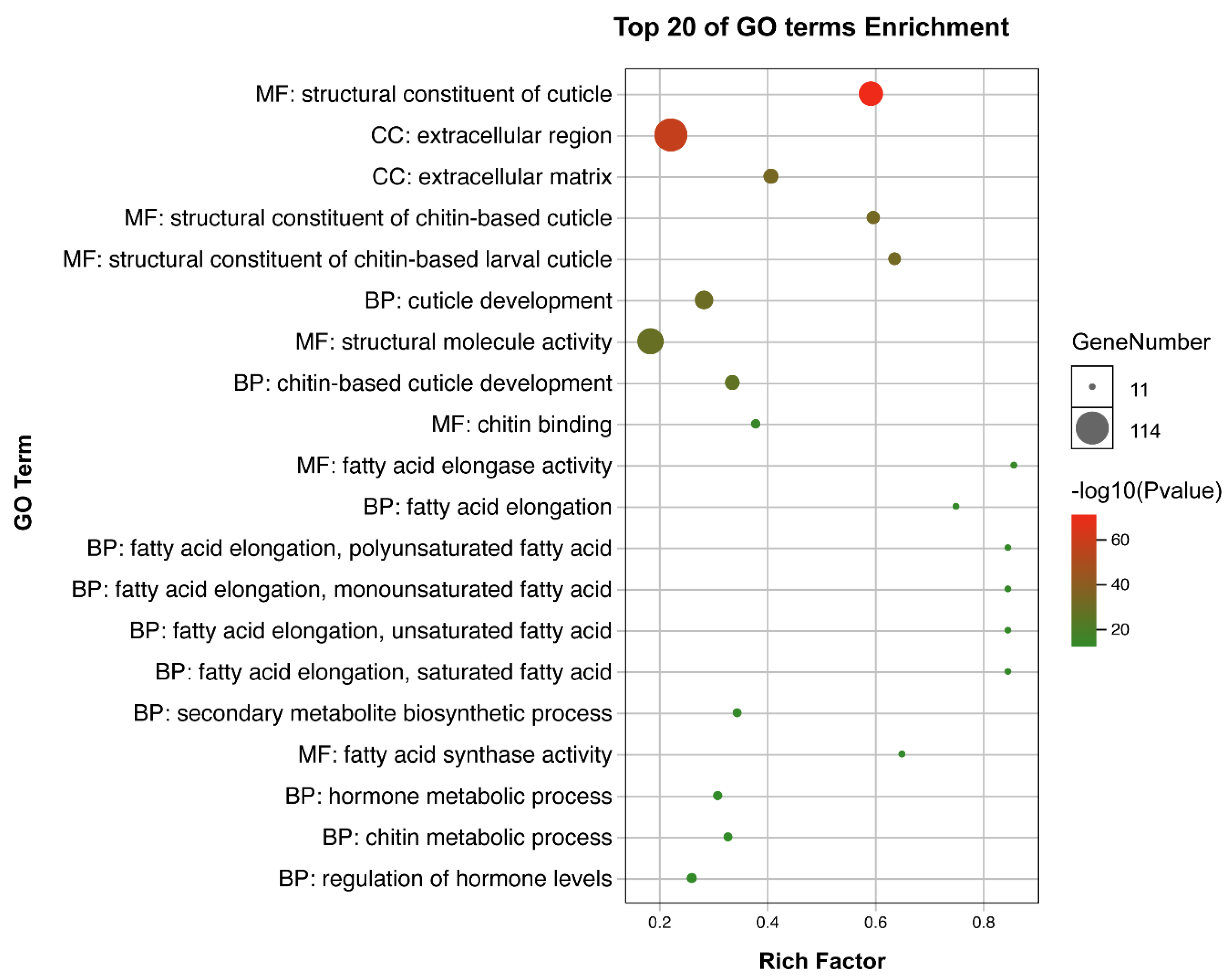
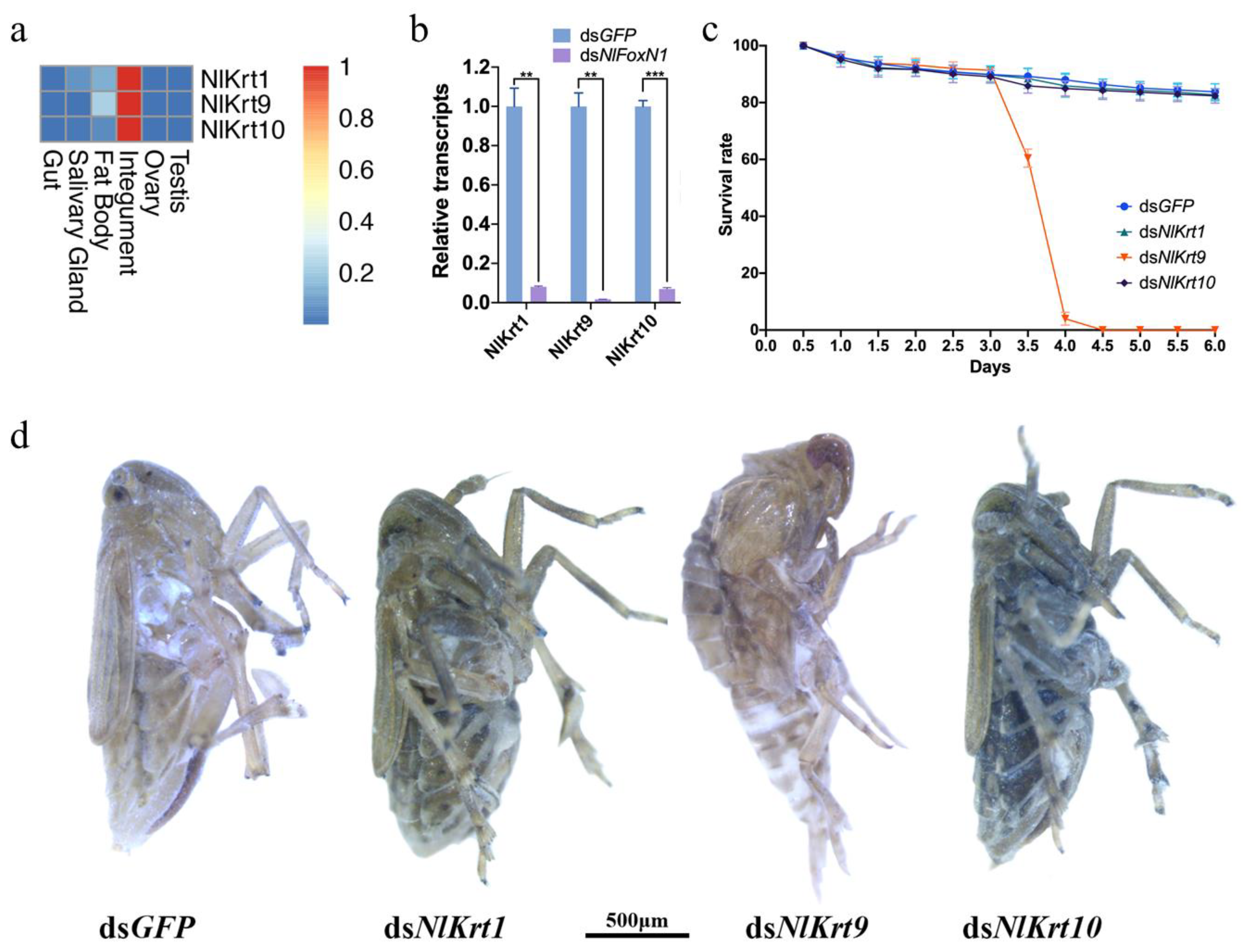
© 2020 by the authors. Licensee MDPI, Basel, Switzerland. This article is an open access article distributed under the terms and conditions of the Creative Commons Attribution (CC BY) license (http://creativecommons.org/licenses/by/4.0/).
Share and Cite
Ye, Y.-X.; Zhang, C.-X. Pleiotropic Functions of FoxN1: Regulating Different Target Genes during Embryogenesis and Nymph Molting in the Brown Planthopper. Int. J. Mol. Sci. 2020, 21, 4222. https://doi.org/10.3390/ijms21124222
Ye Y-X, Zhang C-X. Pleiotropic Functions of FoxN1: Regulating Different Target Genes during Embryogenesis and Nymph Molting in the Brown Planthopper. International Journal of Molecular Sciences. 2020; 21(12):4222. https://doi.org/10.3390/ijms21124222
Chicago/Turabian StyleYe, Yu-Xuan, and Chuan-Xi Zhang. 2020. "Pleiotropic Functions of FoxN1: Regulating Different Target Genes during Embryogenesis and Nymph Molting in the Brown Planthopper" International Journal of Molecular Sciences 21, no. 12: 4222. https://doi.org/10.3390/ijms21124222
APA StyleYe, Y.-X., & Zhang, C.-X. (2020). Pleiotropic Functions of FoxN1: Regulating Different Target Genes during Embryogenesis and Nymph Molting in the Brown Planthopper. International Journal of Molecular Sciences, 21(12), 4222. https://doi.org/10.3390/ijms21124222




